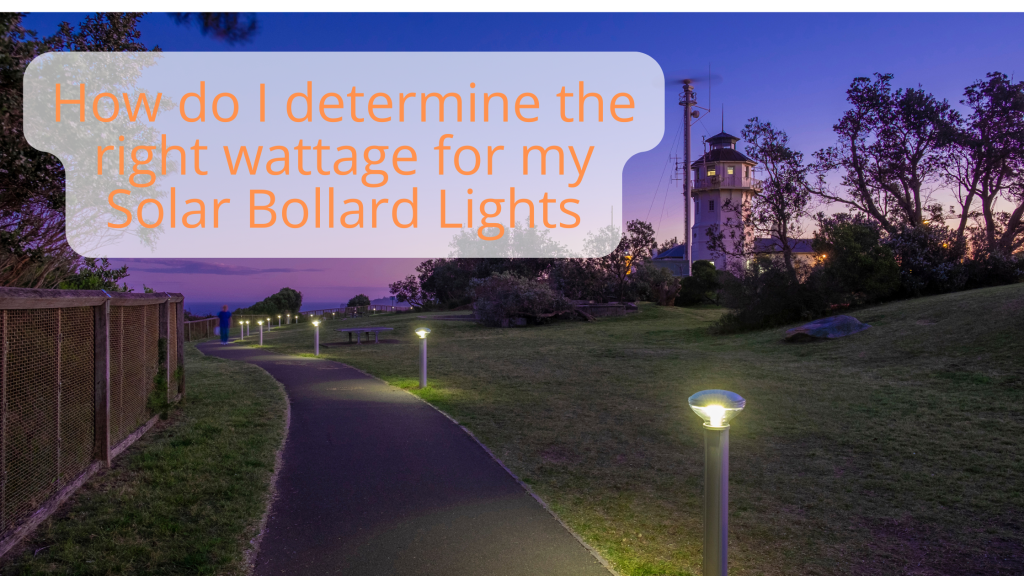
How Do I Determine the Right Wattage for my Solar Bollard Lights?
Determining the right wattage for your solar bollard lights involves several factors to ensure adequate illumination and energy efficiency. Here’s a step-by-step guide to help you choose the appropriate wattage:
- Purpose and Location:
- Purpose: Identify the primary purpose of the lighting. Are you using the lights for pathway illumination, security, or decorative purposes? Higher wattage is typically needed for security and pathway lighting.
- Location: Consider the environment where the lights will be installed. Areas with more ambient light (e.g., urban settings) might need higher wattage to stand out, while darker areas (e.g., rural paths) may require less.
- Desired Brightness:
- Lumens: Determine the brightness needed in lumens, which is often more important than wattage. Wattage refers to energy consumption, while lumens measure the actual light output. For instance, a 5-watt LED might produce 500 lumens, which could be sufficient for general pathway lighting.
- Foot-candles: Evaluate the required foot-candles (the amount of light on a surface). Public walkways may require 1-2 foot-candles, while commercial areas might need more.
- Spacing and Coverage:
- Spacing: Calculate the distance between each bollard. Closer spacing might allow for lower wattage, while wider spacing might necessitate higher wattage to avoid dark spots.
- Coverage: Determine the area each bollard light needs to cover. Larger areas or wider paths may require higher wattage to ensure even illumination.
- Solar Panel and Battery Capacity:
- Solar Panel Efficiency: Check the efficiency of the solar panel. High-efficiency panels can support higher wattage lights even in areas with less sunlight.
- Battery Capacity: Ensure the battery can store enough energy to power the lights through the night. A higher wattage light will need a larger capacity battery.
- Local Climate and Sunlight Availability:
- Climate: In regions with less sunlight or frequent overcast conditions, higher wattage lights with efficient solar panels and larger batteries are recommended.
- Sunlight Hours: Calculate the average peak sunlight hours your location receives to ensure the solar panel can charge the battery sufficiently.
- Energy Efficiency:
- LED Technology: Opt for LED lights, which are more energy-efficient and provide higher lumens per watt compared to other lighting technologies.
- Manufacturer Recommendations:
- Guidelines: Follow the manufacturer’s recommendations and specifications for different applications. They often provide wattage guidelines based on typical use cases.
Example Calculation
For a pathway in a park:
- Purpose: Pathway illumination
- Desired Brightness: 200-300 lumens per light
- Spacing: 10 feet apart
- Solar Panel and Battery: Moderate efficiency with 6-8 hours of peak sunlight
Based on this, a 2-3 watt LED solar bollard light producing 200-300 lumens might be sufficient. Adjust according to your specific needs and environmental conditions. NB, this is a rough estimate.
By considering these factors, you can select the appropriate wattage for your solar bollard lights, ensuring optimal performance and energy efficiency.
Read more:
- Choosing the Right Solar Bollard Light for Commercial Projects
- Illuminate Your Marina: A Guide to Using Commercial Grade Solar Lighting Bollards on Jetties and Pontoons
- Installing the SBL solar bollard lights – very quick and easy.
- Solar bollard lighting shade assessment: upfront planning = successful and reliable solar lighting.
- Solar Lighting Bollards – Your Common Questions Answered
